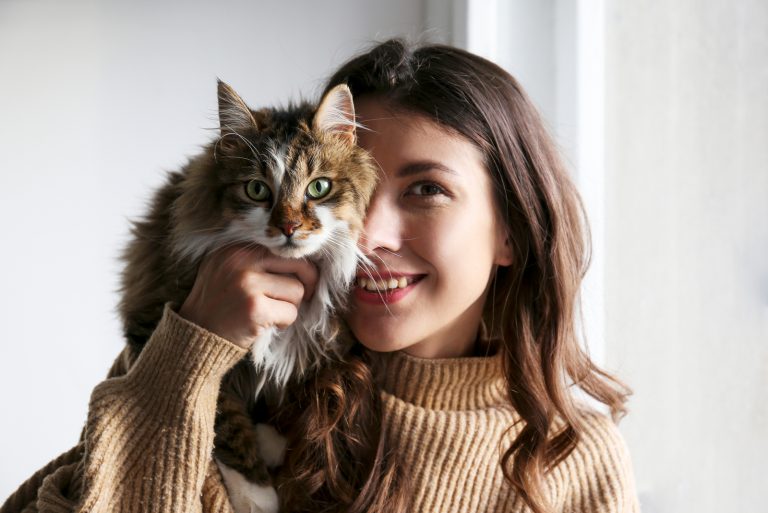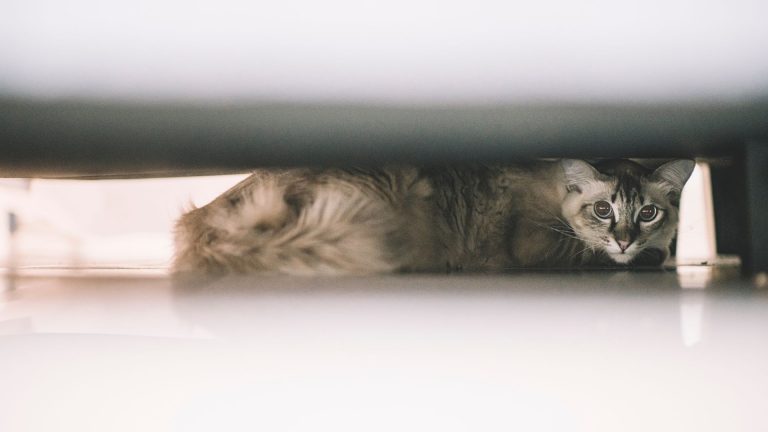Warning Signs When Introducing Cats And How To Do It Properly!

Introducing a new cat to a resident cat can be really challenging. It’s well-known that cats are creatures of routine and that they can have a hard time adjusting to new things, such as a new roommate.
The cat may not like the idea of getting a roommate because she feels threatened and like she should defend her territory.
This is why it’s important to know how to introduce two cats to each other properly to avoid unnecessary complications.
So, if you’re a cat parent, who’s about to get a new cat, read this article to find out the warning signs that you should look out for when introducing cats, and how to introduce cats to each other properly!
14 Important Warning Signs When Introducing Cats
Cats communicate with us through their body language. They cannot tell us what bothers them or what’s wrong, but there are certain cat behaviors that can tell us that something’s up.
Meeting a new cat can be really stressful to your resident cat, and she may show warning signs that may include hissing, meowing, flattened ears, puffed fur, and dilated pupils.
In order to introduce cats properly, and avoid possible fights and potential injuries, here are 14 warning signs that you should know about when introducing cats.
Cats Are Hissing
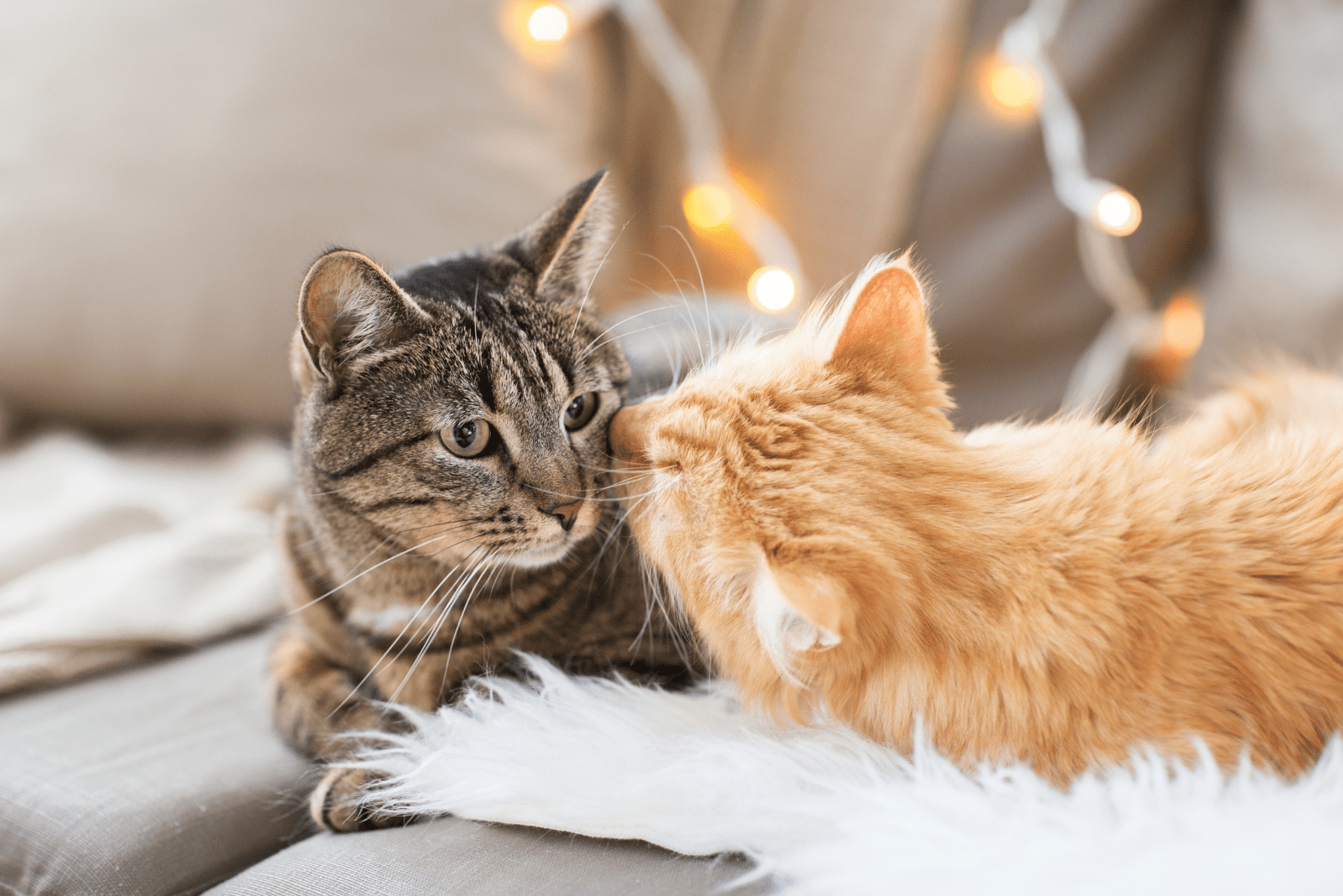
Hissing is a big warning sign in a cat’s language. Cats usually hiss when they’re afraid of something and when they feel threatened. Just like that, when introduced to a new, unfamiliar feline, they may react by hissing, as their routine is disrupted and they feel under threat.
Cats feel threatened when someone else enters their territory. If you notice your cat hissing or swatting during the introduction, that’s a warning sign and it means that you should separate the cats as soon as possible because after hissing, often comes a fight.
So, you should separate cats if you get this kind of reaction, and wait for things to calm down. Don’t give up, it’s likely that both cats just need some time to accept and get used to each other, and the best way to achieve that is to go slowly. A quick cat introduction is rarely successful.
Cats Are Meowing Loudly
Hissing, and the frozen figure, is usually accompanied by loud (and sometimes weird) meowing. The sound is sometimes similar to a baby’s cry. However, this loud meow is a warning sign and a serious threat. The cat that meows like this feels uncomfortable and anxious with another cat in her territory, so by meowing she’s trying to scare her and let her know who’s in charge.
Cats Are Flattening Their Ears
Another recognizable warning sign in cats is flattened ears. Cats usually flatten their ears in the situations where they feel scared, threatened, or anxious. Flattened ears may also be a sign of aggressive behavior in an angry cat.
After flattened ears, the next thing to happen is often an attack! If you want to keep your cat safe and happy, and to hold onto the possibility of them accepting each other, then you should separate the cats as soon as you see one of them has flattened their ears.
Cats Are Snarling

Snarling is a sound that is typical in cats when they’re not happy about something. This sound is similar to growling, but a snarling sound is much louder and higher.
This sound is another warning sign when you introduce your resident cats to a new cat. The main reason for that is because your feline feels threatened by the presence of the new cat, and is expressing the fact that it is anxious and uncomfortable.
Cats Are Growling
Growling, similar to snarling and rumbling, is a warning sign when introducing cats. If you hear your cat growl during the introduction, it means that your feline friend is scared, angry, unhappy or uncomfortable with the new companion.
Usually the dominant cat starts growling as a way of showing dominance and defending its territory. But, if you hear either cat making this or similar sounds, make sure you separate them quickly in order to avoid a fight.
Cats Are Rumbling
Rumbling, similar to the two previously mentioned sounds, is another warning sign that may appear when introducing two cats. It also has the same meaning; your cat is showing unhappiness or fear of losing their territory.
It may also be a sign of jealousy, thinking that their owner will have a new favorite pet. So, always be careful when you hear this sound in cats as it may lead to further aggressive behavior.
Twitching Tail
A twitching tail is also one of the main signs that your cat is nervous, angry, and irritated. This is more common in a multi-cat household, or in cats that don’t like to be bothered too much. Therefore, if you notice your cat’s tail twitching, keep your hands back or you might just get attacked.
Puffed Fur
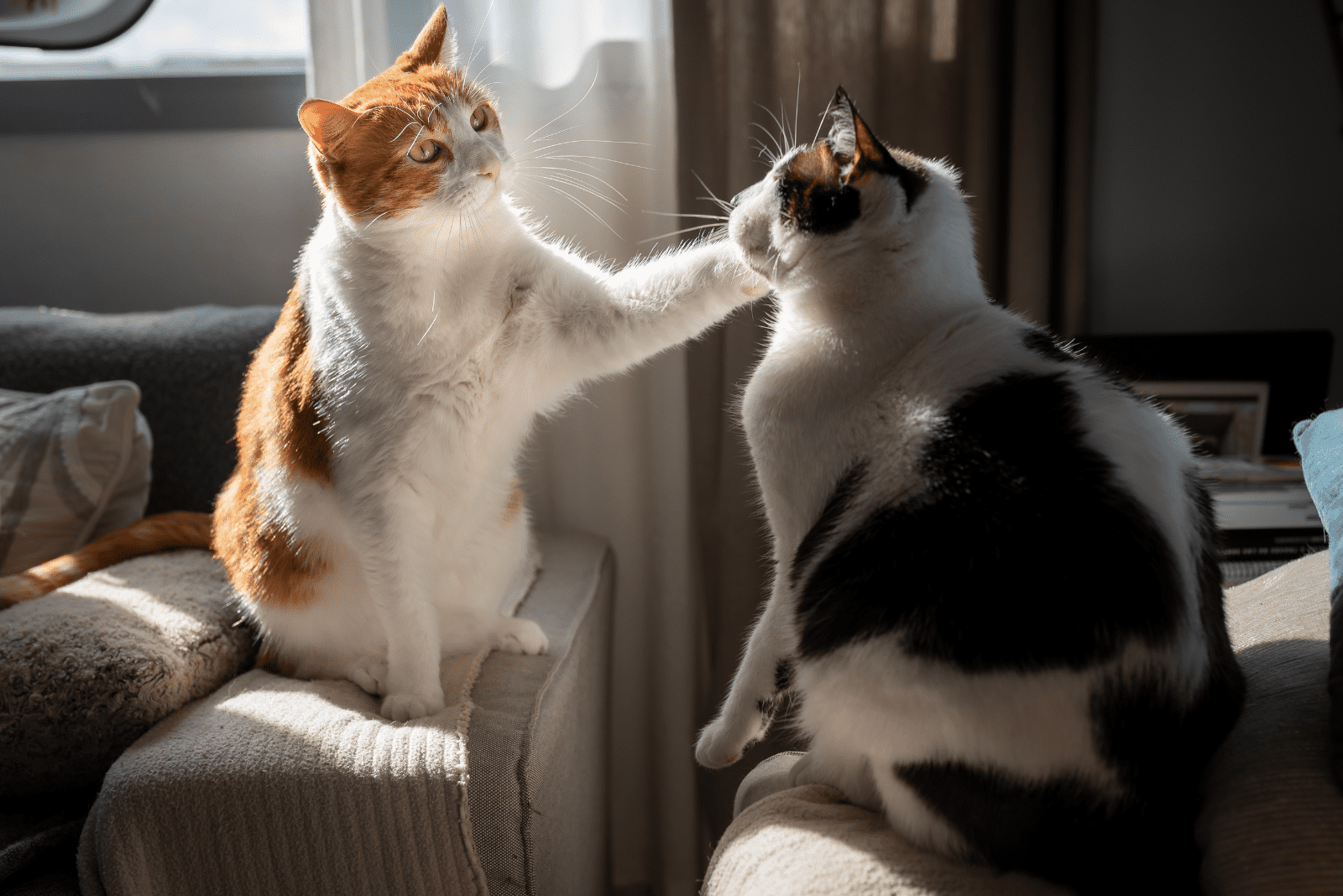
Puffed up fur is, besides the appearance of claws, one of the main defense mechanisms in cats. In case of conflicts or similar, cats puff their fur, mostly on their back and tail.
This is a defense mechanism that they use in situations such as the introduction of another cat, when they’re afraid and feel threatened.
Cats puff their fur in order to make them look bigger, scarier and more dominant, discouraging the new cat from coming closer.
Dilated Pupils
Dilated pupils are common in cats when they are scared or depressed. Therefore, dilated pupils are one of the warning signs when introducing cats to one another.
If you notice dilated pupils in your cat during the introduction, it means that she is scared, uncomfortable, and not ready for the new cat yet.
Cats Are Staring At Each Other
At the beginning of an introduction between two cats, eye contact is a crucial moment. They may just stop and stare at each other for a while. This is a particular behavior for cats facing new cats or confronted by other animals.
If you notice your resident cat staring deeply at the new cat, it may be a sign of developing aggression which could lead to attack.
Therefore, if you notice the “stare” make sure that you separate the cats quickly in order to avoid an attack and prevent a fight. Give them some time and try to introduce them again another time.
Cats Hiding From Each Other
We all know that cats are great at hiding. They usually hide when they’re extremely scared or when they’re in pain. Well, when it comes to cat introduction, this hiding behavior is more typical for less dominant cats.
Less dominant cats will try to avoid being face to face with other cats because they are afraid, therefore they may hide under the table, sofa, or some place else that is difficult to reach.
This behavior is not as typical for dominant cats as they’re more likely to want to confront the less dominant cat, wanting to let her know who’s in charge around here!
Loss Of Appetite

Loss of appetite is another warning sign, and this is typical for both resident and new cat. After the introduction has been made, misunderstandings in communication can still happen. It may happen that one cat doesn’t want to eat.
This usually happens if you feed the cats in the same room. So, your resident cat may stop eating, because she feels threatened by the new cat or simply uncomfortable being vulnerable around it.
On the other hand, if the new cat is less dominant, especially if it’s a younger cat, your resident cat may show more dominance, leading the new cat to be afraid to eat at all. Luckily, there’s a solution for this.
If you want your cats to get along, make sure that you feed them in separate rooms so that each individual cat has its own food bowl filled with its own food, as well as with a water bowl that is always filled with fresh water. That way, you will hopefully avoid possible conflicts during meal time, and help them get along better.
Cats Not Using The Litter Box Properly
Another problem that may occur during the introduction process involves the litter box. This problem is more common in resident cats that feel uncomfortable or nervous around their new roommate; they may start showing this in how they use the litter box.
This problem usually occurs when cats haven’t fully accepted each other. So, when this problem appears, it means that you need to give the cats more time to get used to each other and reassure them.
The best way to do this is to let them be together only under your supervision, and more importantly to provide each cat with their own litter box, in different locations.
Cats Refusing To Accept Each Other
Sometimes, the biggest problem is that the cats refuse to accept each other. That may happen when both resident and the new cat are attempting to achieve dominance and neither of them want to give up.
So, despite all your efforts, your cats may decide not to cooperate. However, if such a situation happens, then you should separate cats into different rooms for a few days, and then try to introduce them again slowly, giving them some time to understand the introduction process as something positive.
If you continue to face this issue, then you can consult with your vet or even an animal behaviorist who can help you with achieving your goal.
How To Introduce Your Cats Properly?

A proper introduction should follow a number of steps. It’s a sometimes difficult and often slow process and you have to give your felines time to fully accept each other.
In the meantime, you should be patient and work on the process and hopefully, in time, everything will be fine and your cats will eventually become best friends.
Step 1: Give The New Cat Some Time
After bringing a new cat home, don’t push them into an initial meeting too quickly. Provide the new kitty with her own space and own equipment, away from your resident kitty. Give her some time to explore the new environment and to get comfortable there.
Every cat owner should be aware that cats often have difficulties adapting to new things, so that’s why it’s important to give the new kitten or cat some time to adjust.
If you rush into the first meeting immediately after bringing the new cat home, it may cause great stress to both pets.
So, after putting the new cat in her own room, give her some time and wait until she becomes comfortable enough to come out to you, and when that happens, you can start to slowly make a proper introduction.
Step 2: Introduction By Scent
After the new cat starts feeling comfortable and safe enough to come out of the room, you can move on to the next step which involves the cat’s scents.
The best way to do that without actually involving the cats just yet, is to take something that one cat used, such as a blanket that has the cat’s scent, and put it in your current cat’s room, away from the cat’s food.
Your cat will probably be interested in it, but it also may upset her. In the beginning the cat may hiss or show signs of aggression, but try to ignore this. Move the blanket closer to her each day and monitor the cat’s behavior.
Finally, when she stops reacting, this means that it’s time for step 3. In the meantime, provide your second cat, the new one, with something that contains the scent of your resident cat, and do the same thing.
Step 3: Swap Their Food Bowls

When the cats stop reacting to each other’s scents, the next step would be swapping their food bowls. That way, cats will be familiar with each other’s scents, and they can also create a positive association between the new feline friend scent and the cat food.
If the cats don’t show any behavior changes during this process, then you can let the cats meet for the first time. However, you still need to look out for any warning signs and separate them if they start showing some of the previously mentioned behaviors. If that happens, then you should go back to step 1 and step 2. If they seem to be getting more comfortable with one another, you can continue with the introduction process.
Step 4: Put Up A See-Through Barrier
The first part of the cats’ visual contact should be through a see-through barrier. So, let the cats see each other but, put a see-through barrier that will be helpful in preventing the cats fighting or similar.
Some cat parents suggest using a baby gate, however, this may not be the best choice as cats can pass through it.
Most importantly, give the cats treats as a reward for their good behavior if they don’t act aggressively.
Step 5: The Real Contact
If step 4 goes well, you can finally let the cats meet face-to-face. They will probably start smelling each other or touch noses, however, they may also react negatively, which means that they’re still not ready for a full introduction.
All in all, just be patient and make sure that you keep a close eye on them. Don’t disrupt them during their moment, and let them do it on their own. At first they may distance from each other, without signs of aggression, which is good.
However, if the cats start fighting or give some warning signs, then you should immediately separate them or make a loud noise that will distract their attention.
How To Know If The Cats Started To Get Along?

The introduction process may take a few days or even longer, depending on the individual cats and their unique behaviors. Some cats may have a hard time accepting the new cat, while some may bond in the blink of an eye.
However, as soon as you notice some of the following behaviors, it would mean that your cats are starting to get along and that they’re going to be best friends.
Cats Licking Each Other
Cats licking each other means they are spreading their scent on each other. Not only is it the cutest thing ever, it also means that your cats are finally becoming affectionate towards each other.
Cats Spending More Time Together
When two cats get along, they spend most of their time together, they lay in the same places, they sleep together, and similar. You will also notice signs of affection between the two cats which means that they’re finally happy and comfortable in each other’s company.
Cats Using The Same Litter Tray
The best way to know if your cats have started to get along is if you notice that they use the same litter box.
The reason for this is that cats will hardly share their litter box with every other cat, and it always has to be clean. Therefore, if one cat allows the second cat to use her litter box, it means that they developed a strong bond.
Cats Playing Together
If you notice your two cats playing together, this is one of the best signs that they have started to get along. Don’t worry about running around, or soft bites; it’s their way of playing. Cats may also share their toys, and all of this means that they enjoy each other’s company.
Cats Cuddling On Each Other
Cats who get along with each other spend most of their time together and they tend to sleep together.
By cuddling close to one another, they feel safe and comfortable, bonding even during their sleep.
What Happens If You Introduce Cats Too Fast?
The cat introduction process should be a slow process so that you don’t put too much pressure on the cats. In fact, you should be very careful and patient, prepare the cats for the introduction and give them time to be ready for the crucial moment.
If you don’t stick to these rules and you introduce cats too quickly, the cats may feel threatened and become more aggressive.
By introducing cats too quickly you risk possible cat fights and this may lead to injuries, after which cats may have a hard time trusting each other again. Therefore, it’s better to follow each step slowly until it’s the right time for the first contact.
FAQ
Should I Let My Cats Fight When They First Meet?
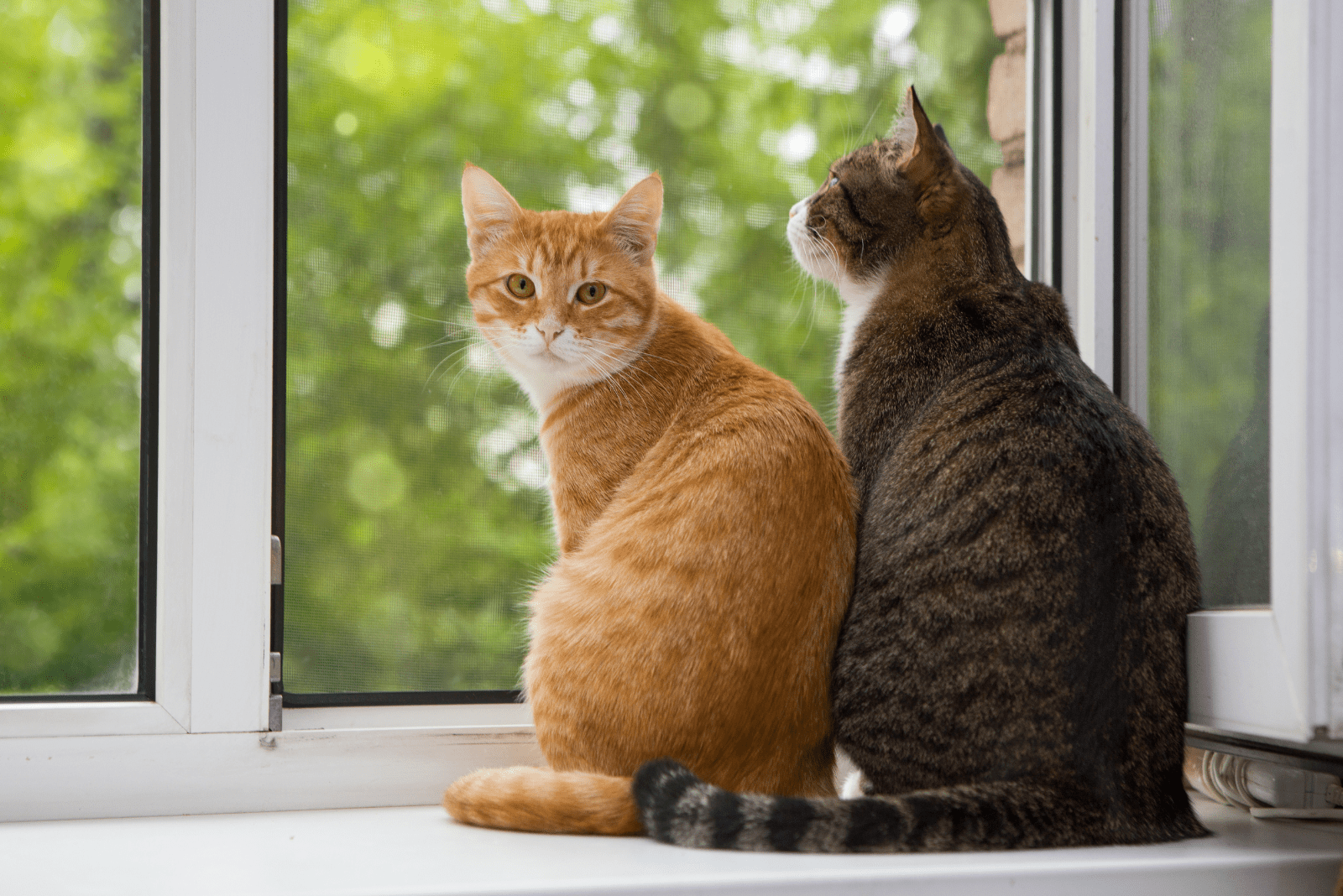
No, you shouldn’t let your cats fight during the first meeting! This may negatively influence their future relationship. If you introduce cats to each other too quickly, they may get into a fight and then later on they may have a hard time trusting each other and bonding.
It’s very important to introduce the two cats slowly and wait for the right moment when they’re both ready for the meeting. If you notice certain warning signs when introducing your cats, you should act immediately by separating the cats into different rooms.
How Long Does It Take For Cats To Get Used To Each Other?
How long it takes for cats to get used to each other depends on the individual cats. Some cats may accept each other within just a few days, while others may take a few weeks or even months. If you’re introducing two adult cats that are both dominant, it may take a bit longer for them to accept each other.
However, if your resident cat is more dominant than the new one, then the bonding may take a shorter period of time. A female and a male cat should bond faster than two males or two female cats as they will be less competitive.
How Do I Know If A Cat Is Getting Too Stressed During Introductions?
There are certain warning signs when introducing cats to one another that will help you notice that your cats are getting too stressed. The most frequent signs of stress include hissing, twitching the tail, loud meowing, flattening the ears, puffing out the fur, and similarly anxious body language.
If you notice some of these warning signs, you can be pretty sure that your cat isn’t happy at all, and the best thing to do is to separate the cats and calm them down.
How Do You Stop Cats From Fighting?
If your cats start fighting during the introduction process, try separating them by making loud noises in order to catch their attention and distract them.
After that, separate the cats into two different rooms and provide each cat with its own food and water bowls, litter box, and other belongings such as toys, cat trees, scratching posts, etc.
In addition, you can try using feliway pheromones in the form of plug-in diffusers that can be very helpful in calming cats down and helping manage their anxiety.
Wrapping It Up!
This article is for every cat owner who plans to get a second cat, as well as for every cat lover who may be interested in doing so in the future.
Cats are creatures of routine and habit, which means that they don’t easily adjust to new things, such as new homes, new people, and new pets. That is why it’s so important to know how to properly introduce two cats to each other.
If you introduce two cats too quickly, they may start to fight, and this delays the bonding process and can create long-lasting issues. The introduction process should be slow and careful. You shouldn’t pressure the cats or introduce them to each other before they’re completely ready for it.
Hopefully, this article will be helpful to you, as it contains 14 warning signs when introducing cats that may help you to react on time and prevent possible fights.
The article also offers you 5 steps of proper introduction that will help you and your cats to bond more easily. Finally, we looked at the important signs that will show you that your cats started to get along which will show you that your mission has been accomplished successfully.



